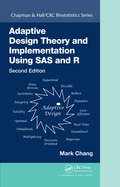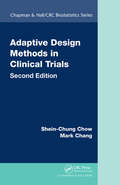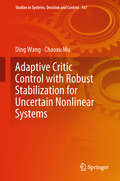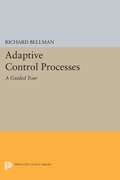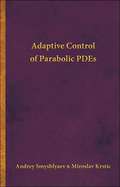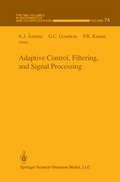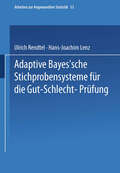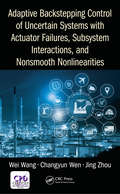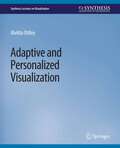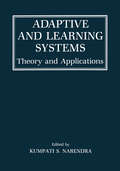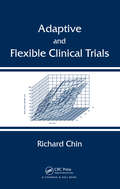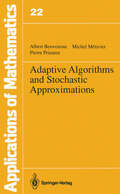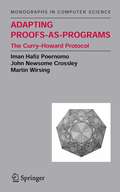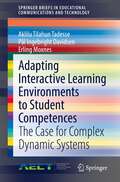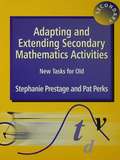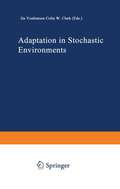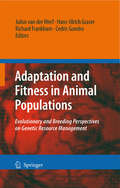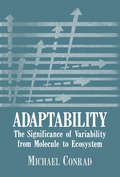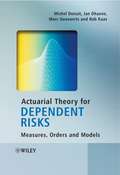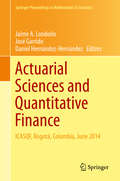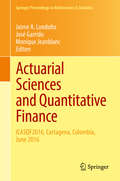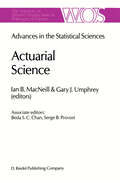- Table View
- List View
Adaptive Design Theory and Implementation Using SAS and R
by Mark ChangGet Up to Speed on Many Types of Adaptive DesignsSince the publication of the first edition, there have been remarkable advances in the methodology and application of adaptive trials. Incorporating many of these new developments, Adaptive Design Theory and Implementation Using SAS and R, Second Edition offers a detailed framework to understand the
Adaptive Design Methods in Clinical Trials
by Shein-Chung Chow Mark ChangWith new statistical and scientific issues arising in adaptive clinical trial design, including the U.S. FDA's recent draft guidance, a new edition of one of the first books on the topic is needed. Adaptive Design Methods in Clinical Trials, Second Edition reflects recent developments and regulatory positions on the use of adaptive designs in clini
Adaptive Critic Control with Robust Stabilization for Uncertain Nonlinear Systems (Studies in Systems, Decision and Control #167)
by Ding Wang Chaoxu MuThis book reports on the latest advances in adaptive critic control with robust stabilization for uncertain nonlinear systems. Covering the core theory, novel methods, and a number of typical industrial applications related to the robust adaptive critic control field, it develops a comprehensive framework of robust adaptive strategies, including theoretical analysis, algorithm design, simulation verification, and experimental results. As such, it is of interest to university researchers, graduate students, and engineers in the fields of automation, computer science, and electrical engineering wishing to learn about the fundamental principles, methods, algorithms, and applications in the field of robust adaptive critic control. In addition, it promotes the development of robust adaptive critic control approaches, and the construction of higher-level intelligent systems.
Adaptive Control Processes: A Guided Tour (PDF)
by Richard E. BellmanThe aim of this work is to present a unified approach to the modern field of control theory and to provide a technique for making problems involving deterministic, stochastic, and adaptive processes of both linear and nonlinear type amenable to machine solution. Mr. Bellman has used the theory of dynamic programming to formulate, analyze, and prepare these processes for numerical treatment by digital computers. The unique concept of the book is that of a single problem stretching from recognition and formulation to analytic treatment and computational solution. Due to the emphasis upon ideas and concepts, this book is equally suited for the pure and applied mathematician, and for control engineers in all fields.Originally published in 1961.The Princeton Legacy Library uses the latest print-on-demand technology to again make available previously out-of-print books from the distinguished backlist of Princeton University Press. These editions preserve the original texts of these important books while presenting them in durable paperback and hardcover editions. The goal of the Princeton Legacy Library is to vastly increase access to the rich scholarly heritage found in the thousands of books published by Princeton University Press since its founding in 1905.
Adaptive Control of Parabolic PDEs (PDF)
by Andrey Smyshlyaev Miroslav KrsticThis book introduces a comprehensive methodology for adaptive control design of parabolic partial differential equations with unknown functional parameters, including reaction-convection-diffusion systems ubiquitous in chemical, thermal, biomedical, aerospace, and energy systems. Andrey Smyshlyaev and Miroslav Krstic develop explicit feedback laws that do not require real-time solution of Riccati or other algebraic operator-valued equations. The book emphasizes stabilization by boundary control and using boundary sensing for unstable PDE systems with an infinite relative degree. The book also presents a rich collection of methods for system identification of PDEs, methods that employ Lyapunov, passivity, observer-based, swapping-based, gradient, and least-squares tools and parameterizations, among others. Including a wealth of stimulating ideas and providing the mathematical and control-systems background needed to follow the designs and proofs, the book will be of great use to students and researchers in mathematics, engineering, and physics. It also makes a valuable supplemental text for graduate courses on distributed parameter systems and adaptive control.
Adaptive Control, Filtering, and Signal Processing (The IMA Volumes in Mathematics and its Applications #74)
by K. J. Aström G. C. Goodwin P. R. KumarThe area of adaptive systems, which encompasses recursive identification, adaptive control, filtering, and signal processing, has been one of the most active areas of the past decade. Since adaptive controllers are fundamentally nonlinear controllers which are applied to nominally linear, possibly stochastic and time-varying systems, their theoretical analysis is usually very difficult. Nevertheless, over the past decade much fundamental progress has been made on some key questions concerning their stability, convergence, performance, and robustness. Moreover, adaptive controllers have been successfully employed in numerous practical applications, and have even entered the marketplace.
Adaptive Bayes’sche Stichprobensysteme für die Gut-Schlecht-Prüfung (Arbeiten zur Angewandten Statistik #33)
by Ulrich Rendtel Hans-Joachim LenzAdaptive Backstepping Control of Uncertain Systems with Actuator Failures, Subsystem Interactions, and Nonsmooth Nonlinearities
by Wei Wang Changyun Wen Jing ZhouIn practice, actuators often undergo failures and various factors influence its effectiveness. Also due to the increasing complexity of large-scale systems, subsystems are often interconnected, whereas the interactions between any two subsystems are difficult to deal with. This book details a series of new methodologies of designing and analyzing adaptive backstepping control systems involving treatment on actuator failures, subsystem interactions and nonsmooth nonlinearities. Moreover, it discusses some interesting open issues in adaptive failure accommodation, decentralized adaptive control and distributed adaptive coordinated control.
Adaptive Backstepping Control of Uncertain Systems with Actuator Failures, Subsystem Interactions, and Nonsmooth Nonlinearities
by Wei Wang Changyun Wen Jing ZhouIn practice, actuators often undergo failures and various factors influence its effectiveness. Also due to the increasing complexity of large-scale systems, subsystems are often interconnected, whereas the interactions between any two subsystems are difficult to deal with. This book details a series of new methodologies of designing and analyzing adaptive backstepping control systems involving treatment on actuator failures, subsystem interactions and nonsmooth nonlinearities. Moreover, it discusses some interesting open issues in adaptive failure accommodation, decentralized adaptive control and distributed adaptive coordinated control.
Adaptive and Personalized Visualization (Synthesis Lectures on Visualization)
by Alvitta OttleyThere is ample evidence in the visualization community that individual differences matter. These prior works highlight various personality traits and cognitive abilities that can modulate the use of the visualization systems and demonstrate a measurable influence on speed, accuracy, process, and attention. Perhaps the most important implication of this body of work is that we can use individual differences as a mechanism for estimating when a design is effective or to identify when people may struggle with visualization designs. These effects can have a critical impact on consequential decision-making processes. One study that appears in this book investigated the impact of visualization on medical decision-making showed that visual aides tended to be most beneficial for people with high spatial ability, a metric that measures a person’s ability to represent and manipulate two- or three-dimensional representations of objects mentally. The results showed that participants with low spatial ability had difficulty interpreting and analyzing the underlying medical data when they use visual aids. Overall, approximately 50% of the studied population were unsupported by the visualization tools when making a potentially life-critical decision. As data fluency continues to become an essential skill for our everyday lives, we must embrace the growing need to understand the factors that may render our tools ineffective and identify concrete steps for improvement. This book presents my current understanding of how individual differences in personality interact with visualization use and draws from recent research in the Visualization, Human-Computer Interaction, and Psychology communities. We focus on the specific designs and tasks for which there is concrete evidence of performance divergence due to personality. Additionally, we highlight an exciting research agenda that is centered around creating tailored visualization systems that are aligned with people’s abilities. The purpose of this book is to underscore the need to consider individual differences when designing and evaluating visualization systems and to call attention to this critical research direction.
Adaptive and Learning Systems: Theory and Applications
by Kumpati S. NarendraThis volume offers a glimpse of the status of research in adaptive and learning systems in 1985. In recent years these areas have spawned a multiplicity of ideas so rapidly that the average research worker or practicing engineer is overwhelmed by the flood of information. The Yale Workshop on Applications of Adaptive Systems Theory was organized in 1979 to provide a brief respite from this deluge, wherein critical issues may be examined in a calm and collegial environment. The fourth of the series having been held in May 1985, it has now become well established as a biennial forum for the lively exchange of ideas in the ever changing domain of adaptive systems. The scope of this book is broad and ranges from theoretical investigations to practical applications. It includes twenty eight papers by leaders in the field, selected from the Pro ceedings of the Fourth Yale Workshop and divided into five sections. I have provided a brief introduction to each section so that it can be read as a self-contained unit. The first section, devoted to adaptive control theory, suggests the intensity of activity in the field and reveals signs of convergence towards some common themes by workers with rather different moti vation. Preliminary results concerning the reduced order model problem are dramatically changing the way we view the field and bringing it closer to other areas such as robust linear control where major advances have been recently reported.
Adaptive and Flexible Clinical Trials
by Richard ChinAdaptive clinical trial designs, unlike traditional fixed clinical trial designs, enable modification of studies in response to the data generated in the course of the trial. This often results in studies that are substantially faster, more efficient, and more powerful. Recent developments in web-based real-time data entry and advances in statistic
Adaptive Algorithms and Stochastic Approximations (Stochastic Modelling and Applied Probability #22)
by Albert Benveniste Michel Metivier Pierre PriouretAdaptive systems are widely encountered in many applications ranging through adaptive filtering and more generally adaptive signal processing, systems identification and adaptive control, to pattern recognition and machine intelligence: adaptation is now recognised as keystone of "intelligence" within computerised systems. These diverse areas echo the classes of models which conveniently describe each corresponding system. Thus although there can hardly be a "general theory of adaptive systems" encompassing both the modelling task and the design of the adaptation procedure, nevertheless, these diverse issues have a major common component: namely the use of adaptive algorithms, also known as stochastic approximations in the mathematical statistics literature, that is to say the adaptation procedure (once all modelling problems have been resolved). The juxtaposition of these two expressions in the title reflects the ambition of the authors to produce a reference work, both for engineers who use these adaptive algorithms and for probabilists or statisticians who would like to study stochastic approximations in terms of problems arising from real applications. Hence the book is organised in two parts, the first one user-oriented, and the second providing the mathematical foundations to support the practice described in the first part. The book covers the topcis of convergence, convergence rate, permanent adaptation and tracking, change detection, and is illustrated by various realistic applications originating from these areas of applications.
Adapting Proofs-as-Programs: The Curry--Howard Protocol (Monographs in Computer Science)
by Iman Poernomo John N. Crossley Martin WirsingThis monograph details several important advances in the direction of a practical proofs-as-programs paradigm, which constitutes a set of approaches to developing programs from proofs in constructive logic with applications to industrial-scale, complex software engineering problems. One of the books central themes is a general, abstract framework for developing new systems of programs synthesis by adapting proofs-as-programs to new contexts.
Adapting Interactive Learning Environments to Student Competences: The Case for Complex Dynamic Systems (SpringerBriefs in Educational Communications and Technology)
by Aklilu Tilahun Tadesse Pål Ingebright Davidsen Erling MoxnesThis monograph focuses on the design of personalized and adaptive online interactive learning environment (OILE) to enhance students’ learning in and about complex dynamic systems (CDS). Numerous studies show that students experience difficulties when learning in and about CDS. The difficulties are due to challenges originating from a) the structural complexity of CDS, (b) the production of dynamic behavior from the underlying systems structure, and (c) methods, techniques and tools employed in the analysis of such systems. Despite the fact that studies have uncovered such learning challenges, it is still not well understood how we may effectively address these challenges. In this monograph, the authors provide some answers as to how we may best improve our cognitive capabilities to meet these challenges by way of effective instructional methods, techniques, and tools and their implementation in the form of an OILE. The OILE developed for this purpose, builds on a five-step holistic instructional design framework; identification of instructional design models, identification of authentic learning material, identification of instructional methods, identification of instructional techniques, and design of the interface and implementation of the tool. In this OILE development, six well-documented instructional design models were considered; a four component instructional design, first principles of instruction, constructivists learning environment, task centered instruction, cognitive apprenticeship, and elaboration theory.
Adapting and Extending Secondary Mathematics Activities: New Tasks FOr Old
by Stephanie Prestage Pat PerksThis book is designed to assist teachers to get the most out of the textbooks or mathematics schemes used in their schools, providing methods of extending the activities offered to learners.
Adapting and Extending Secondary Mathematics Activities: New Tasks FOr Old
by Stephanie Prestage Pat PerksThis book is designed to assist teachers to get the most out of the textbooks or mathematics schemes used in their schools, providing methods of extending the activities offered to learners.
Adaptation in Stochastic Environments (Lecture Notes in Biomathematics #98)
by Jin Yoshimura Colin W. ClarkThe classical theory of natural selection, as developed by Fisher, Haldane, and 'Wright, and their followers, is in a sense a statistical theory. By and large the classical theory assumes that the underlying environment in which evolution transpires is both constant and stable - the theory is in this sense deterministic. In reality, on the other hand, nature is almost always changing and unstable. We do not yet possess a complete theory of natural selection in stochastic environ ments. Perhaps it has been thought that such a theory is unimportant, or that it would be too difficult. Our own view is that the time is now ripe for the development of a probabilistic theory of natural selection. The present volume is an attempt to provide an elementary introduction to this probabilistic theory. Each author was asked to con tribute a simple, basic introduction to his or her specialty, including lively discussions and speculation. We hope that the book contributes further to the understanding of the roles of "Chance and Necessity" (Monod 1971) as integrated components of adaptation in nature.
Adaptation and Fitness in Animal Populations: Evolutionary and Breeding Perspectives on Genetic Resource Management
by Richard Frankham Cedric Gondro Hans-Ulrich Graser Julius Van Der WerfFitness and adaptation are fundamental characteristics of plant and animal species, enabling them to survive in their environment and to adapt to the inevitable changes in this environment. This is true for both the genetic resources of natural ecosystems as well as those used in agricultural production. Extensive genetic variation exists between varieties/breeds in a species and amongst individuals within breeds. This variation has developed over very long periods of time. A major ongoing challenge is how to best utilize this variation to meet short-term demands whilst also conserving it for longer-term possible use. Many animal breeding programs have led to increased performance for production traits but this has often been accompanied by reduced fitness. In addition, the global use of genetic resources prompts the question whether introduced genotypes are adapted to local production systems. Understanding the genetic nature of fitness and adaptation will enable us to better manage genetic resources allowing us to make efficient and sustainable decisions for the improvement or breeding of these resources. This book had an ambitious goal in bringing together a sample of the world’s leading scientists in animal breeding and evolutionary genetics to exchange knowledge to advance our understanding of these vital issues.
Adam Ries (Biographien hevorragender Naturwissenschaftler, Techniker und Mediziner)
by Hans WussingEs gibt historische Zufälle, die symbolhaften Charakter tragen. Im Jahre 1492 wurden am Fuße des erzgebirgischen Schreckensteins reiche Silbervorkommen entdeckt. Tausende von Menschen strömten auf das neuerliche "Berggeschrei" in diese Gegend. Die Silbergräbersiedlung erhielt schon vier Jahre danach das Stadt recht und wurde bald darauf in "Sanct Annaberg" umbenannt. Die heilige Johanna galt als Schutzpatronin der Bergleute. Im selben Jahre 1492 wurde Adam Ries geboren. Nach Jugend und Wanderjahren ließ er sich in jener Stadt Annaberg nieder, die, genau so alt wie er, zu einem Zentrum des europäischen Frühkapitalismus werden sollte und zugleich den Ruhm bean spruchen kann, die hauptsächliche Wirkungsstätte des "Rechen meisters des deutschen Volkes" gewesen zu sein. Und noch in einer anderen Weise ist das Jahr 1492 symbolträch tig. Der in spanischen Diensten stehende italienische Seefahrer Christoph Columbus betrat erstmals die Neue Welt, Amerika. Vervollkommnung und Verbreitung neuer, moderner Rechenme thoden, an denen Adam Ries maßgeblich beteiligt war, und die überaus rasche Ausdehnung des Weltmarktes im Gefolge der gro ßen geographischen Entdeckungen des 16. Jahrhunderts stellen nur verschiedene Aspekte eines durchgreifenden historischen der bei einer raschen Entwicklung der Produktiv Umbruchs dar, kräfte zur Entfaltung des Frühkapitalismus in Europa führte.
Actuarial Theory for Dependent Risks: Measures, Orders and Models
by Michel Denuit Jan Dhaene Marc Goovaerts Rob KaasThe increasing complexity of insurance and reinsurance products has seen a growing interest amongst actuaries in the modelling of dependent risks. For efficient risk management, actuaries need to be able to answer fundamental questions such as: Is the correlation structure dangerous? And, if yes, to what extent? Therefore tools to quantify, compare, and model the strength of dependence between different risks are vital. Combining coverage of stochastic order and risk measure theories with the basics of risk management and stochastic dependence, this book provides an essential guide to managing modern financial risk. * Describes how to model risks in incomplete markets, emphasising insurance risks. * Explains how to measure and compare the danger of risks, model their interactions, and measure the strength of their association. * Examines the type of dependence induced by GLM-based credibility models, the bounds on functions of dependent risks, and probabilistic distances between actuarial models. * Detailed presentation of risk measures, stochastic orderings, copula models, dependence concepts and dependence orderings. * Includes numerous exercises allowing a cementing of the concepts by all levels of readers. * Solutions to tasks as well as further examples and exercises can be found on a supporting website. An invaluable reference for both academics and practitioners alike, Actuarial Theory for Dependent Risks will appeal to all those eager to master the up-to-date modelling tools for dependent risks. The inclusion of exercises and practical examples makes the book suitable for advanced courses on risk management in incomplete markets. Traders looking for practical advice on insurance markets will also find much of interest.
Actuarial Sciences and Quantitative Finance: ICASQF, Bogotá, Colombia, June 2014 (Springer Proceedings in Mathematics & Statistics #135)
by Jaime A. Londoño José Garrido Daniel Hernández-HernándezFeaturing contributions from industry and academia, this volume includes chapters covering a diverse range of theoretical and empirical aspects of actuarial science and quantitative finance, including portfolio management, derivative valuation, risk theory and the economics of insurance. Developed from the First International Congress on Actuarial Science and Quantitative Finance, held at the Universidad Nacional de Colombia in Bogotá in June 2014, this volume highlights different approaches to issues arising from industries in the Andean and Carribean regions. Contributions address topics such as Reverse mortgage schemes and urban dynamics, modeling spot price dynamics in the electricity market, and optimizing calibration and pricing with SABR models.
Actuarial Sciences and Quantitative Finance: ICASQF2016, Cartagena, Colombia, June 2016 (Springer Proceedings in Mathematics & Statistics #214)
by Jaime A. Londoño José Garrido Monique JeanblancDeveloped from the Second International Congress on Actuarial Science and Quantitative Finance, this volume showcases the latest progress in all theoretical and empirical aspects of actuarial science and quantitative finance. Held at the Universidad de Cartagena in Cartegena, Colombia in June 2016, the conference emphasized relations between industry and academia and provided a platform for practitioners to discuss problems arising from the financial and insurance industries in the Andean and Caribbean regions. Based on invited lectures as well as carefully selected papers, these proceedings address topics such as statistical techniques in finance and actuarial science, portfolio management, risk theory, derivative valuation and economics of insurance.
Actuarial Science: Advances in the Statistical Sciences Festschrift in Honor of Professor V.M. Josh’s 70th Birthday Volume VI (The Western Ontario Series in Philosophy of Science #39)
by I. B. MacNeill G. UmphreyOn May 27-31, 1985, a series of symposia was held at The University of Western Ontario, London, Canada, to celebrate the 70th birthday of Pro fessor V. M. Joshi. These symposia were chosen to reflect Professor Joshi's research interests as well as areas of expertise in statistical science among faculty in the Departments of Statistical and Actuarial Sciences, Economics, Epidemiology and Biostatistics, and Philosophy. From these symposia, the six volumes which comprise the "Joshi Festschrift" have arisen. The 117 articles in this work reflect the broad interests and high quality of research of those who attended our conference. We would like to thank all of the contributors for their superb cooperation in helping us to complete this project. Our deepest gratitude must go to the three people who have spent so much of their time in the past year typing these volumes: Jackie Bell, Lise Constant, and Sandy Tarnowski. This work has been printed from "camera ready" copy produced by our Vax 785 computer and QMS Lasergraphix printers, using the text processing software TEX. At the initiation of this project, we were neophytes in the use of this system. Thank you, Jackie, Lise, and Sandy, for having the persistence and dedication needed to complete this undertaking.
